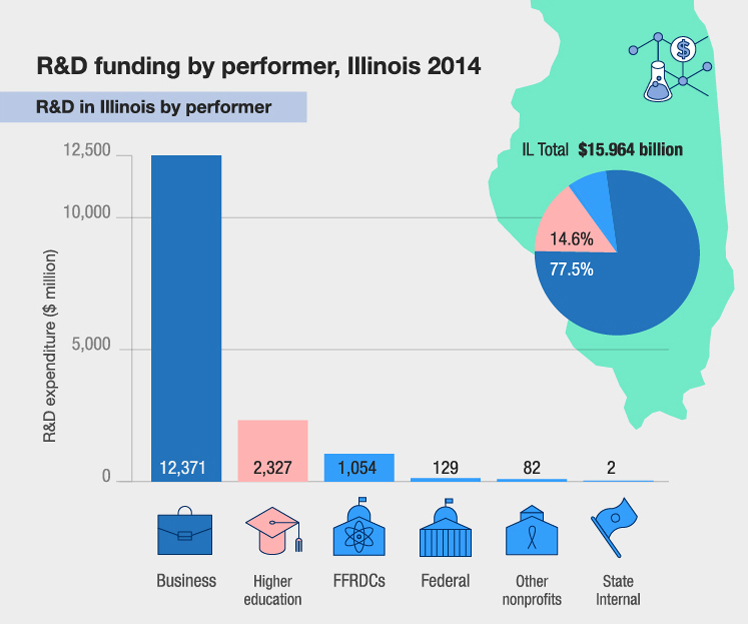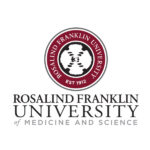Q/A with Dr. Alicia Löffler
Associate Provost for Innovation and New Ventures;
Associate Vice President for Research; and Executive Director, INVO,
Northwestern University
In this issue of Catalyst, we sit down with ISTC/I Board Member Dr. Alicia Löffler to discuss how Northwestern is helping to commercialize the university’s groundbreaking research and promoting innovation and entrepreneurship on campus. These efforts include strong research partnerships with industry, which ISTC’s recently released R&D Innovation Index shows are key to boosting cross-sector innovation. We also ask her about her own career trajectory and why she feels optimistic about Chicago’s tech community.
You hold several titles at Northwestern – can you briefly summarize each of your roles and describe how research, innovation and entrepreneurship are integrated across campus?
Innovation at Northwestern lives everywhere. It doesn’t reside at any particular center or School or group of Schools; it is everywhere and it is integrated in the fabric of the institution. However, to be effective and sustainable, all efforts need to be closely aligned with the academic and research missions of the university. My titles reflect that reality. As an Executive Director of the Innovation and New Ventures Office, I oversee all university-wide commercialization and new ventures efforts. As Associate Provost for Innovation, I ensure that our programs enhance the academic experiences for our students; as an Associate Vice President of Research, I look for ways of enhancing the commercial impact of our faculty.
Walk us through how the University works with its researchers to commercialize their innovations? What does the process look like from discovery through commercialization?
The University is an incubator of talent and ideas that spark and generate a broad range of innovations – from arts to drugs and from software to hardware. There is no linear, or typical path towards commercialization. Our job is to (1) provide an environment that supports the diverse collision of ideas that allow innovations to emerge, and (2) create mechanisms to identify those innovations with potential commercial value. Once the commercial potential is identified, we work on the individual assets to make the innovation “industry/startup ready.” We increase the value of the assets by seeding their development with funding, protecting them with intellectual property rights, and positioning them in the marketplace. To help with this, Northwestern has two venture seed funds: N.XT (research driven innovations) and NUseeds (student startups). In addition, Northwestern has two accelerators: NewCures for therapeutics and Wildfire for digital innovations that provide non-dilutive funding and mentorship.
Clearly, an entrepreneurial university like Northwestern produces more ideas than we can possibly fully develop, consequently we can only focus effectively on a handful at a given time. Screening, segregating, and prioritizing the assets are key to what we do. Details vary according to the level. At the undergraduate level, we have a variety of curricular and extracurricular programs that help us screen and select potential innovations. Similarly, research-driven innovations, generated by graduate students and faculty, are vetted by external experts before we invest with commercialization resources. In general, innovations that reach The Garage (Northwestern’s student incubator) have been already screened and vetted by classes, competitions, etc.
What makes the Northwestern environment so conducive to commercialization of business ideas, not just in science heavy fields like drug discovery (e.g. Lyrica) but also a company like Narrative Science, which came out of Computer Science and Medill?
Great innovations represent solutions to problems that break the existing status-quo. Innovative solutions/products rarely emerge from a single discipline, but bring together disparate perspectives – technology, policy, business, psychology, etc. The McCormick School of Engineering has coined the term “Whole Brain Thinking” to illustrate the Northwestern approach to innovation. This means integrating the elements of left-brain thinking – analysis, logic, synthesis, and math – with the right-brain thinking that promotes intuition, arts, and creativity. Northwestern leads in this approach to problem solving. The institution is small enough so that it is easy for faculty to navigate and create strong, unconventional, interdisciplinary collaborations on one side, but also large enough to house top-ranked programs in all of the major disciplines: arts, engineering, business, medicine, etc. Narrative Science is just one example of innovation coming from the intersection of two disparate disciplines: computer science and journalism.
ISTC’s recently released Illinois Innovation Index focuses on R&D in the state, including initiatives that bring together academia and industry. What are the necessary ingredients to make these partnerships successful? What are some of the key industry partnerships and trends you are observing at Northwestern?
There are many common ingredients of successful partnerships including: (1) clear purpose and structure, (2) free flow of information among the researchers, (3) an understanding that partnerships have a life cycle, (4) dedicated qualified management, (5) shared philosophies and empathy for the respective institutional missions. This last point is perhaps the most critical for academic-industry interactions.
Successful academic-industry partnerships share an understanding of the circular nature of research – commercial applications drive scientific discoveries and scientific discoveries drive commercial applications. We shouldn’t partner as a way to sponsor research but rather to increase the quality and impact of the research. This understanding provides the basis for productive partnerships wherein there is free-flow of knowledge, equitably contributions, and benefits.
An important trend today is to partner at the pre-competitive stage. By pooling resources with academia at the pre-competitive level industry gains a very fertile ground for trial and error; they can see which areas could have commercial potential and which would fail. In turn, these collaborations increase the impact and innovative power of the science created at Northwestern . We have benefited from these pre-competitive collaborations and a vibrant dialogue with many Illinois-based firms such as Baxter, AbbVie, and Exelon.
You studied biochemical engineering and have previously worked on several biotech startups. What advice would you give PhD and post-doctoral researchers who want to explore a more entrepreneurial career path?
Three points: “Explore”, “Listen”, and “Do”
Explore. Graduate students and post-docs are uniquely positioned to explore, try, fail, and try again. This is the time for students to explore and take advantage of all of the opportunities that the University has to offer. At Northwestern, students can choose from a myriad of programs, including the Kellogg summer leadership programs tailored for science students, The Garage’s entrepreneurial programs, INVO fellowships, and many more.
Listen. This is also the time for students to listen carefully, be humble, and learn from mentors and alums that have taken the entrepreneurial path. Entrepreneurs work at the intersection of innovation and execution. And mentors will teach by example how to best execute on the vision.
Do. Entrepreneurship in fact means to “undertake” and “to do.” This is the time for students to “jump, take risks, and try.” This is harder than it seems.
At Northwestern, we rely on graduate students and postdocs to help us spinout most of the research driven innovations. While involvement of the principal faculty member is key, he or she is usually too embedded in a purely academic path that doesn’t easily align with the needs and demands of the entrepreneurial world. The postdocs or students are the ones that make it all happen.
Though you’ve been at Northwestern for 20+ years, you’re a native of Buenos Aires and have studied on both coasts – what is your perspective of the Chicago regional tech community and how would you assess our prospects for the coming decade?
It has been really exciting to experience the transformational growth of the tech community in Chicago, catalyzed by 1871’s vision. Chicago has become a place where our young tech alums want to be. I am even more excited to see how that culture is now expanding to other areas. The outstanding success of Outcome Health, founded by two Northwestern alums (Rishi Shah and Shradha Agarwal) bridging digital and health care, is opening a fertile new dimension for Chicago. Tempus, founded by Groupon co-founder Eric Lefkofsky, is also leading the path in that direction. Chicago has one of the largest healthcare delivery clusters. While Boston and San Francisco dominate in biomedical products, Illinois leads in end-to-end biomedical enterprise – from clinicals to products and healthcare adoption. The intersection of biomedical and digital will be the next wave of innovation in Chicago in the next 10 years.
ICYMI
Last week, the ISTC released the latest Illinois Innovation Index, highlighting research and development (R&D) activity in the state, and benchmarking R&D volume and growth relative to peer states. This issue of the Index comes at a pivotal moment for (R&D) in the United States: Although the economic benefits of R&D are well known, vital funding is currently under threat — both nationally and in Illinois. Read more to see how Illinois is performing.
What we’re reading
- Argonne division director to companies: “We are open for business” [Chicago Tribune]
- The Hatchery plans $30M food incubator for East Garfield Park [Next City]
- A college town gets ready for its moment under no sun [The New York Times]
- Why we love Flyover Country [Impact Engine via Chicago Inno]
- Wellsping acquires Covalent Data [Wellspring]
- Start-up execs urge Trump not to kill special ‘start-up visa’ for entrepreneurs [CNBC]
- International Entrepreneur Rule: What might it mean for U.S. workers? [New American Economy]
- What does it take to make venture capital work in cleantech? Energy Foundry shares insights [Inside Sources]
- New funding from Google and a partnership with Uptake will boost STEM programs at Blue1647 [Chicago Inno]
- Fermilab in Batavia to be part of ground-breaking global science experiment [Kane County Chronicle]
- With Illinois budget deal secured, public universities still face challenges [Chicago Tribune]
- DOE awards $104M in funding for bioenergy research center at U of I [Peoria Public Radio]
- Chicago “Tech50” List 2017 [Crain’s Chicago Business]
- North Chicago students’ school-based health clinic idea becomes reality [Chicago Tribune]
- It’s getting harder for kids to move up the economic ladder. He’s got ideas how to fix that. [Chicago Tribune]
- IBIC Applauds Senators Durbin and Graham for bipartisan DREAM Act [IBIC]
Welcome New Board Chair and Members!

The ISTC/I would like to welcome Shelley Stern Grach, Director of Civic Engagement for Microsoft Chicago, as our first ever Chairwoman of our Board of Directors! Shelley has served on the ISTC board since April 2016, and you can read more about her and the rest of our board here.
We also welcome Rosalind Franklin University of Medicine and Science as a university member of the Coaltion. A long-standing asset to Lake County in creating economic value, Rosalind Franklin just received $2.8 million to advance breakthrough research on neurological repair. Per our most recent Index report, the university’s new Innovation Park (to be announced later this year) will create 500 new jobs with an economic impact of $117M.
Featured Opportunity: Nominate a company for the Fourth Revolution Awards!
 The Fourth Revolution Awards celebrates regional manufacturing for its leadership and innovation as the industry stands on the brink of a new technological revolution. The ceremony culminates in the presentation of eight awards to deserving leaders, companies and industrial initiatives that have made significant contributions to the Chicago region’s manufacturing ecosystem. Together, we will ensure that Chicagoland manufacturing is driven by innovation, infused with world-class talent, and continues its reign as a global leader into the future. The Fourth Revolution Awards is an initiative of ISTC members UI Labs, and ISTC partners mHub and the Illinois Manufacturing Excellence Center (IMEC). ISTC President and CEO Mark Harris will serve as one of the judges for the awards. Nominate a company here.
The Fourth Revolution Awards celebrates regional manufacturing for its leadership and innovation as the industry stands on the brink of a new technological revolution. The ceremony culminates in the presentation of eight awards to deserving leaders, companies and industrial initiatives that have made significant contributions to the Chicago region’s manufacturing ecosystem. Together, we will ensure that Chicagoland manufacturing is driven by innovation, infused with world-class talent, and continues its reign as a global leader into the future. The Fourth Revolution Awards is an initiative of ISTC members UI Labs, and ISTC partners mHub and the Illinois Manufacturing Excellence Center (IMEC). ISTC President and CEO Mark Harris will serve as one of the judges for the awards. Nominate a company here.




